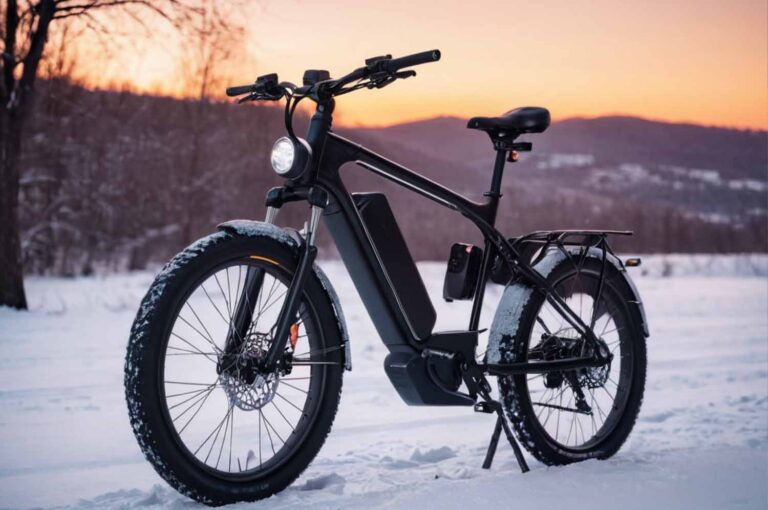E-Bike & Public Transport: The Winter Student’s Guide to Efficient Travel
Combining electric bikes (e-bikes) with public transportation can be an effective solution, aiding in traversal through snow and freezing conditions.
E-bikes offer the flexibility and ease of personal transport while requiring less physical exertion than traditional bicycles, which is a significant advantage in cold climates.
Public transport, on the other hand, provides shelter and long-distance travel, which might be more difficult or uncomfortable on an e-bike during winter.
The integration of e-bikes and public transport can have a positive impact on the environment by reducing the reliance on personal vehicles, which are major contributors to greenhouse gas emissions.
This hybrid commuting method can lead to significant improvements in urban air quality, benefiting public health and contributing to the sustainability efforts of cities.
Furthermore, e-bikes promote physical activity, which is crucial for maintaining health, especially during months when outdoor activities can be limited due to harsh weather conditions.
For students, the combination of e-bikes and public transport represents not only a practical but also an economical option.
It can reduce the costs associated with car ownership, such as fuel, maintenance, and parking, and provides a degree of independence that may not be achievable through public transport alone.
As cities continue to develop infrastructure to support e-bikes, this mode of transportation is becoming increasingly accessible, positioning it as a valuable component in the future of urban mobility for students during winter.
Table of Contents
E-Bike Advantages for Students
Health and Environmental Benefits
E-bikes support active travel, which is key to fostering better health among students. Unlike traditional vehicles, e-bikes require pedaling, though with less effort thanks to electric assist.
This form of moderate exercise can enhance cardiovascular health and improve mood. Additionally, e-bikes contribute to sustainability efforts. They emit no pollutants during operation, making them an eco-friendly option compared to gas-powered vehicles.
- Physical Activity: Encourages daily exercise through pedaling.
- Mental Well-Being: Boosts serotonin and dopamine levels, enhancing mood and concentration.
- Carbon Footprint: Significantly lower compared to cars, contributing to reduced greenhouse gas emissions.
Cost-Effectiveness and Convenience
E-bikes provide a faster mode of transportation compared to walking, as outlined by Ride1Up, especially beneficial when one has to traverse a campus quickly or maneuver through crowded city streets.
The affordability aspect is also notable, as e-bikes circumvent the ongoing costs associated with vehicles, such as fuel, insurance, and parking fees.
Moreover, e-bikes can be a more attainable option for students than other electric transportation forms.
- Time Efficiency: Quicker than walking and can navigate through traffic easier than cars.
- Maintenance Costs: Generally lower than cars and even some public transport options.
- Initial Investment: While higher than regular bikes, e-bikes offer long-term savings on transport costs.
Public Transport Systems and Winter Accessibility
During winter, public transportation systems must overcome severe challenges to maintain accessibility and comfort for commuters.
Ensuring smooth transit experiences often demands adapting to cold temperatures and managing precipitation effectively.
Challenges Faced by Commuters
Commuters dealing with winter conditions encounter numerous obstacles that can hinder their use of public transportation. Main challenges include:
- Weather Conditions: Freezing temperatures, snowfall, and icy paths compromise safety and the reliability of services.
- Delays and Disruptions: Increased instances of delays due to weather-related impacts on equipment and infrastructure.
Commuter Data: Winter Season Impediments
| Impediment | Commuter Impact |
|---|---|
| Snow Accumulation | Slowed or halted services |
| Icy Platforms | Increased risk of falls |
| Reduced Visibility | Transit mishaps |
| Extreme Cold | Waiting discomfort |
Synergy of E-Bikes and Public Transport

The integration of electric bikes (e-bikes) into public transport systems offers an effective solution for sustainable urban mobility, especially during winter months when students face unique commuting challenges.
Case Studies of Effective Bike-Sharing Systems
Several cities globally have implemented electric bike-sharing systems that exemplify the successful synergy between cycling infrastructure and public transport.
- Case Study 1: In cities like Copenhagen, dedicated cycling lanes and established bike-sharing programs facilitate an accessible and seamless transition between e-bikes and public transport, even in cold weather.
- Case Study 2: Amsterdam’s bike-sharing system is integrated with its public transport network, providing an efficient multimodal commuting option that supports thousands of students and commuters daily.
Both cases highlight the critical role of a robust cycling infrastructure and the availability of an electric bike-sharing system to enhance the effectiveness of multimodal transport solutions.
Influence of Student Lifestyle on Transport Choices
Students’ transport choices are profoundly influenced by their attitudes and perceptions, particularly in the winter season, alongside the role their academic institutions play in shaping these preferences.
Attitudes and Perceptions of Winter Cycling
Students often view winter cycling as challenging but are influenced by an attitude that values sustainable mobility and flexibility.
The Theory of Planned Behavior suggests that their positive attitudes toward cycling can translate into actual travel behavior. Factors such as perceived ease of use and the physical infrastructure of roads can encourage or deter students from choosing bicycles as a winter mode of transportation.
- Key Factors Influencing Winter Cycling Attitude Among Students:
- Accessibility of well-maintained bike lanes
- Availability of bike storage facilities
- Perception of safety while cycling in winter conditions
Role of Academic Institutions
Academic institutions can play a significant role in promoting sustainable transport modes like e-bikes and public transport among students.
Through the provision of facilities and services that support these modes, along with educating students about their benefits, institutions can positively impact students’ travel choices.
- Institutional Support for Sustainable Mobility:
- Installation of secure bike racks and maintenance stations
- Partnerships with local public transport providers to offer student discounts
- Campaigns promoting the health and environmental benefits of cycling and public transport use
Policy Implications for Winter Cycling and Transportation
Policymakers face the challenge of encouraging winter e-cycling as a sustainable transportation mode among students. To this end, it is vital to implement incentive programs.
For example, subsidies for e-bike purchases can make this option more financially accessible.
Additionally, educational campaigns highlighting the low-carbon benefits of e-cycling, paired with guidance on safe winter cycling practices, can motivate students to adopt this mode of transportation.
- Incentive Programs:
- Subsidies or rebates for e-bike purchase
- Free or discounted e-bike rentals
- Educational Campaigns:
- Workshops on winter e-bike safety
- Distribution of information on the environmental benefits of e-cycling
Designing Policies for Sustainable Student Commuting
The design of cycling infrastructure is crucial to address the barriers to winter cycling and support sustainable transportation.
Policies should focus on creating protected bike lanes that are maintained throughout the winter to reduce traffic congestion and improve safety.
Additionally, integrating bike storage and parking solutions near public transport stations enhances the synergy between e-bikes and public transportation, creating a cohesive commuting experience for students.
- Infrastructure Improvements:
- Establishing and maintaining protected bike lanes
- Snow and ice removal from cycling paths
- Public Transport Integration:
- Secure bike storage at transit stops
- Increased bus and train capacity for e-bike transport
Technological Developments in E-Biking
The realm of electrically assisted cycling, or e-cycling, has seen substantial technological progress, enhancing motorized transport on two wheels.
These advancements are reshaping the landscape of urban mobility, especially for students commuting in winter conditions.
Innovation in Electrically Assisted Cycling
Manufacturers have made significant strides in pedal-assisted e-bike technology.
Motor enhancements provide smoother acceleration and more intuitive power delivery, closely mimicking the experience of traditional biking while reducing the effort required by the rider.
For instance, newer e-bike models boast improved battery technology that extends range and reduces charging time. Here’s a glimpse into the technological enhancements:
- Battery Efficiency: Advanced lithium-ion batteries offer longer life spans.
- Regenerative Braking: Systems that recharge the battery during braking.
- Smart Integration: E-bikes now feature connectivity with smartphones for navigation and fitness tracking.
Advances in Bicycle-Sharing Technologies
Bicycle-sharing programs have integrated e-bikes into their fleets, greatly expanding user accessibility and convenience. Technology has played a crucial role in this advancement, most notably through:
- Smart Docks and Locks: Enabling secure parking and charging of e-bikes.
- App-Based Control: Riders can locate, unlock, and pay for e-bike usage directly from their smartphones.
RFID and GPS technology are widely used to prevent theft and to track bicycles, ensuring they can be easily located by users through bicycle-sharing applications. These technologies foster a safer and more reliable e-cycling experience, encouraging their use in combination with public transport during all seasons.
E-Bike Usage in Diverse Spatial Contexts
E-bike adoption is growing, though usage patterns vary significantly between urban and rural areas, influenced by factors like infrastructure and bikeability.
Urban Versus Rural E-Cycling
In urban areas, e-bikes act as a compelling solution to traffic congestion and are a key component of urban mobility strategies.
Their electric assist mechanism makes them more appealing than traditional bicycles, especially over longer distances or hilly terrain.
Unlike rural regions, cities typically offer more comprehensive cycling infrastructure, which can include dedicated bike lanes and traffic signals for cyclists.
These facilitated conditions contribute to a higher e-bike usage rate in urban settings.
In contrast, rural areas present a mixed scenario for e-bike adoption. While e-bikes could potentially transform mobility for rural residents by bridging longer distances, the lack of cycling infrastructure typically makes these areas less bikeable.
The potential of e-bikes for important demographics such as commuters, rural residents, and students is significant, yet infrastructure developments are essential to realize this potential.
Cycling Infrastructure Quality and Bikeability
Bikeability in any spatial context is largely determined by the quality of cycling infrastructure. Good infrastructure includes smooth pavement, adequate lighting, and proper signage, which together enhance safety and the overall cycling experience.
It also involves connectivity to key destinations like schools, offices, and shopping areas, which is pertinent for students who often depend on efficient and affordable transportation methods in winter.
High-quality cycling infrastructure is crucial not only for safety but also for encouraging the use of e-bikes as a primary mode of transportation.
Improved bikeability can lead to a positive substitution effect, replacing car trips with e-bike journeys, thus contributing to sustainable mobility practices, especially in congested urban areas.
Research and Literature Review
The integration of electric bicycles (e-Bikes) with public transport is seen as a potential game-changer for commuting students during winter, merging the flexibility of cycling with the broader reach of public transport networks.
Studies on E-Bike and Public Transport Efficiency
Extensive research has been conducted on the synergy between bicycles and public transportation systems, exploring factors that contribute to successful adoption and efficient operation.
A systematic literature review hosted on the Web of Science and ORIA databases indicates that combining e-Bikes with public transportation can expand catchment areas and improve accessibility.
A significant study found in the literature reveals the importance of infrastructure, such as secured parking and integrated ticketing systems, in facilitating this multi-modal transport approach.
Survey Methodologies and Descriptive Statistics
Surveys have been a primary tool for gathering descriptive statistics on the usage patterns of e-Bikes in combination with public transport.
Researchers employing both online and offline survey methodologies have been able to characterize user demographics, seasonal usage variations, and commute times.
These surveys often result in numeric summaries, such as percentages or averages, allowing for a clear and concise presentation of the current state of e-Bike usage among winter students.
For instance, a survey conducted among university students revealed that:
- 58% of e-Bike users combined their ride with public transport during winter months.
- 45% cited reduced transportation time as the primary reason for choosing an e-Bike over other modes of transport.
These descriptive statistics underscore the practical benefits students experience when integrating e-Bikes into their winter commute.
Social Considerations for Bicycle-Public Transport Integration
Integrating bicycles, including electrically assisted cycling (e-bikes), with public transport systems can have significant social implications.
It’s essential to understand the impacts on various social groups when promoting sustainable mobility and reducing automobility.
Active travel options like cycling are not uniform across demographics. For instance, a study highlighted that age, gender, and residence location significantly influence cycling practices.
E-bike advancements have the potential to alter the social representation of cycling, appealing to those who may find physical barriers with conventional bikes.
| Age Group | Impact of E-bikes |
|---|---|
| Youth and Adults | Increased range and convenience |
| Seniors | Enhanced accessibility to cycling |
The synergy between bicycles and public transportation can encourage a shift from car use to more environmentally friendly modes of transport.
As demonstrated in North American cities, facilities such as bike racks on buses and bike parking at stations enhance the use of combined transport methods.
Furthermore, the integration needs to consider equity in access. While many initiatives focus on urban centers, ensuring rural and suburban areas are included can address mobility needs across a broader spectrum of the population.
In terms of policy, local schemes emphasize the importance of inclusivity in transport planning.
By taking into account the varying needs and preferences of different social groups, cities can foster a more diverse cycling culture that complements the public transport system effectively.
In summary, bicycle-public transport integration should empower individuals to adopt healthier and more sustainable travel habits, while acknowledging and addressing the social factors that shape mobility choices.
Comparative Analysis
E-Bikes Versus Conventional Bicycles
E-bikes offer distinct advantages over conventional bicycles, particularly in a winter context. Motorized assistance is the key differentiator; it is especially beneficial in cold weather when riders are likely to expend more energy to combat resistance from heavy clothing and potentially snowy conditions.
Studies, like those published in Transport Reviews, highlight how this assistance can reduce the effort required by the rider, thus increasing the likelihood of choosing an e-bike over a conventional bicycle.
Additionally, e-bikes typically feature more robust designs, which provide better traction and stability on slippery surfaces.
The impact of e-bikes on travel behavior indicates that they can encourage more frequent and longer trips, as their ease of use decreases the barrier posed by cold, inclement weather.
Competitiveness Among Various Transport Modes
In an urban environment, the efficiency of transport modes often influences a student’s choice of commute.
E-bikes stand out for their competitive edge in these scenarios due to their low operating costs and reduced travel times compared to public transport or car use during peak hours.
Their benefits are only amplified during winter months when delays and disruptions are common for buses and trains, as noted in research from Environmental Science & Policy.
Competing with cars, e-bikes offer a sustainable and agile alternative that can navigate through traffic with ease, significantly reducing commute times.
The comparative life cycle assessment of e-bikes emphasizes their lower environmental impact over cars, making them a competitive and eco-friendly option for winter students’ commutes.



